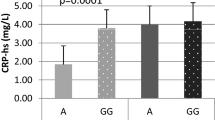Abstract
Dependence of plasma total homocysteine (tHcy) and DNA damage profiles on melanodialdehyde (MDA), oxidative stress, liver function tests (LFT), and lipids was studied in non-obese and obese subjects in the Pakistani population. Development of obesity is influenced by both genetic, biochemical and environmental factors. Plasma homocysteine (Hcy) and DNA damage profiles play a pivotal role in its progression. We studied 160 obesity patients and 160 lean subjects. Leukocytes were evaluated for DNA damage by comet assay and blood plasma for biochemical properties using commercial kits. Plasma Hcy level and DNA damage were strongly correlated with triglycerides (P < 0.000), LDL-cholesterol (P < 0.001), systolic blood pressure (P < 0.001), cholesterol (P < 0.004), MDA (P < 0.004) and total oxygen stress (P < 0.004) in obese individuals. Both Hyc and DNA damage were negatively associated with total anti-oxidant response and globulin. Both Hcy profile and DNA damage may have a role in the endothelium damage even in the normal range and are related to triglycerides, ALT, MDA, TOS, HDL- and LDL-cholesterol in the Pakistani population.
Similar content being viewed by others
References
Kumar J, Sunkishala RR, Karthikeyan G, Sengupta S (2007) The common genetic variant upstream of INSIG2 gene is not associated with obesity in Indian population. Clin Genet 71:415–418
Bessesen DH (2008) Update on obesity. J Clin Endocrinol Metab 93:2027–2034
Hossain P, Bisher K, EI-Nahas M (2007) Obesity and diabetes in the developing world—a growing challenge. N Engl J Med 356:973
Haslam DW, James WP (2005) Obesity. Lancet 366:1197–1209
Anonymous (2006) Working together for health. World Health Organization, Geneva
Dudeja V, Misra A, Pandey RM, Devina G, Kumar G, Vikram NK (2001) BMI does not accurately predict overweight in Asian Indians in northern India. Brit J Nutr 86:105–112
Scott JM (2000) Homocysteine and cardiovascular risk. Am J Clin Nutr 72:333–334
Donald WJ (2000) Hyperhomocysteinemia and oxidative stress time for a reality check? Arterioscler Thromb Vasc Biol 20:1182–1184
Kanani PM, Sinkey CA, Browning RL, Allaman M, Knapp HR, Hayness WG (1999) Role of oxidant stress in endothelial dysfunction produced by experimental hyperhomocyst(e)inemia in humans. Circulation 100:1161–1168
Alla R, Friedrich I, Ben-Amotz A, Levy Y (2002) Low plasma antioxidants and normal plasma B vitamins and homocysteine in patients with severe obesity. IMAJ 4:590–593
Henning BF, Tepel M, Riezler R, Gillessen A, Doberauer C (1998) Vitamin supplementation during weight reduction—favourable effect on homocysteine metabolism. Res Exp Med 198:37–42
Dandona P, Mohanty P, Ghanim H, Aljada A, Browne R, Hamouda W, Prabhara A, Afzal A, Garg R (2001) The suppressive effect dietary restriction and weight loss in the obese on the generation of reactive oxygen species by leukocytes, lipid peroxidation, and protein carbonylation. J Clin Endocrinol Metab 86:355–362
Fridovich I (1998) Oxygen toxicity: a radical explanation. J Exp Biol 219:1203–1209
Sondike SB, Copperman N, Jacobson MS (2003) Effects of a low-carbohydrate diet on weight loss and cardiovascular risk factor in overweight adolescents. J Pediatr 142(3):253–258
Grundy SM (2007) Metabolic syndrome pandemic. Arterioscler Thromb Vasc Biol 28:629–636
Bruckert E, Giral PRecziu V, Poynard T, Champan MJ, Opolon P, Turpin G (2002) A constellation of cardiovascular risk factors is associated with hepatic enzyme elevation in hyperlipidemic patients. Metabolism 51:1071–1076
Erel O (2005) A new automated colorimetric method for measuring total oxidant status. Clin Biochem 38:1103–1111
Erel O (2004) A novel automated method to measure total antioxidant response against potent free radical reactions. Clin Biochem 37:112–119
Prazny M, Skrha J, Hilgertova J (1999) Plasma malondialdehyde and obesity: is there a relationship? Clin Chem Lab Med 37:1129–1130
Martin FL, Cole KJ, Williams JA, Millar BC, Harvey D, Weaver G, Grover PL, Phillip PH (2000) Activation of genotoxins of DNA-damage species in exfoliated breast milk cells. Mutat Res 470:115–124
Steel RGD, Torrie JH, Dickey DA (1997) Principles and procedures of statistics, 3rd edn. McGraw Hill Book Co. Inc., New York
He Q, Ding ZY, Fong DYT, Karlberg J (2000) Blood pressure is associated with body mass index in both normal and obese children. Hypertension 36:165–170
Jafar TH, Chaturvedi N, Pappas G (2006) Prevalence of overweight and obesity and their association with hypertension and diabetes mellitus in an Indo-Asian population. Can Med Assoc J 175(9):1071–1077
Burns CJ, Boswell JM, Olsen GW (1996) Liver enzymes activity and body mass index. J Occup Environ Med 38:1248–1252
Choi JW (2003) Association between elevated serum hepatic enzyme activity and total body fat in obese humans. Ann Clin Lab Sci 33(3):256–264
Acknowledgments
These studies were supported by Higher Education Commission, Punjab Government and University of Agriculture, Faisalabad. Ethical Committee is thanked for permission to carry out this work. Lab staff and Departmental statistician are thanked for their assistance.
Author information
Authors and Affiliations
Corresponding author
Rights and permissions
About this article
Cite this article
Bukhari, S.A., Rajoka, M.I., Nagra, S.A. et al. Plasma homocysteine and DNA damage profiles in normal and obese subjects in the Pakistani population. Mol Biol Rep 37, 289–295 (2010). https://doi.org/10.1007/s11033-009-9686-0
Received:
Accepted:
Published:
Issue Date:
DOI: https://doi.org/10.1007/s11033-009-9686-0




